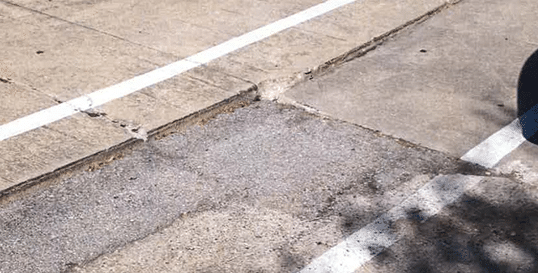Potholes, Cracks and Other Treacherous Road Conditions for Cyclists

Issue: Can you recover from a City/State Government in Texas for injuries caused by a road defect?
Answer: No. It’s almost impossible to recover for damages caused by road defects.
Discussion: Governmental entities are generally immune from liability based on the concept of “governmental immunity” (based on the common law concept of “you can’t sue the King.”). That immunity has been waived to a very limited extent based upon the Texas Tort Claims Act.
When it comes to road defects, there are two potential claims. The first requires proof that the hazard is a “special defect,” which Texas case law defines as something like a large ditch or excavation that would cause a car to crash. Texas Supreme Court and Appellate Court cases have made it clear that a special defect for a bike and a car is the same. If it wouldn’t cause a car to crash (like say a 10’ drop-off), then it’s not a special defect for a bike. There is no Texas case that has ruled that a cycling road hazard like a pothole, grate, unequal pavement, etc. was a “special defect.”
The second theory of liability is based on a “premises liability” claim under which the cyclist must prove that the City or State had “actual knowledge” of the defect. Actual knowledge means just that. You must prove that the government entity was aware that a hazard actually existed at the time of the incident. “Should have known” (constructive knowledge) doesn’t suffice.
As shown below, proving actual knowledge is almost impossible, but even if the entity had “actual knowledge,” if the defect is “open and obvious” then the entity could still avoid liability.
The Paper Case is Bad for Cyclists: The definitive case involving cyclists and road defects is the Texas Supreme Court’s 2012 decision in City of Denton v. Paper, 376 S.W.2d 762 (2012). A cyclist fell as a result of a pothole that was near a sewer. The Texas Supreme Court first ruled that pothole was not a “special defect.”
Regarding the “actual notice” issue, the evidence showed that the City had repaired the pothole the week before. According to maintenance employees, supposedly, the street was level. The City then had to return the next day for a subsequent repair because the sewer line had sunk. Despite the foregoing, the Texas Supreme Court found no actual notice stating:
“The City … had not received any complaints about the project or the street repair between the project’s completion on March 23 and Paper’s accident a week later on April 1.”
- An example is if a City employee negligently injures or kills someone while driving. Even so, damages are limited to $250,000.
- After reviewing pictures of defects, Texas Appellate Courts have uniformly found that all defects are open and obvious, and that the cyclist could have just gone around the defect. It is fair to surmise that most Texas Appellate Judges have not ridden a bike since they were youngsters riding some clunker.
“The City arguably knew that the repaired area of the street might sink again but the actual knowledge required for liability is of the dangerous condition at the time of the accident, not merely of the possibility that a dangerous condition can develop over time. Awareness of a potential problem is not actual knowledge of an existing danger.”
What the Paper case shows is that it’s almost impossible to prevail on a road defect case. To avoid liability, a government entity only has to say that when the repair work was done, everything was level and hazard free, and furthermore, that they had received no complaints after completing the work and the time of the incident.
City of Richardson v. Phelps, 05-18-00753-CV (Tex. App. – Dallas, 2019). In 2016, my client was on a casual social group ride called the “Sunday Roll.” The group of 18 riders was riding at 16-18 mph on a Richardson street with a designated bike lane. (See below.) The car on the right squeezed the group to the left, including my client. He didn’t see the lip because of the other cyclists. He went down hard and was injured.


I argued that the hazard was a “special defect” for the intended user (cyclist instead of a motor vehicle). The Dallas Court of Appeals ruled otherwise.
As for the City’s actual knowledge of the defect, I was able to show that two years before, a cyclist had sent an email with a photo to the City complaining of a defect in the same area. The City then came out and repaired that defect. After the repair, the bike lane was established and painted. At some point before the incident (2016), the City tried to repair the lip as shown by the picture below. This repair was done after the bike lane was created because the patch actually covered the right painted bike lane. City employees testified to this fact as well.

The Dallas Court of Appeals held that even though the City had known of a defect and repaired it before, that this was not “actual” knowledge that the defect existed at the time the patch was placed by the City because it is presumed that the City fixed the lip at the time the patch was placed. (Similar to Paper.)
In short, proofing actual knowledge on the part of a City/Government entity is very unlikely.
This reflects a bias on the part of Texas Courts against cyclists for sure, but the reality of the situation is that little can be done about it short of legislation. And I wouldn’t hold my breath on that happening.
